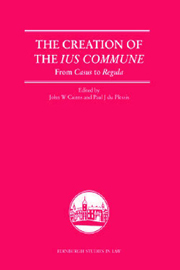Book contents
- Frontmatter
- Contents
- Preface
- List of Contributors
- List of Abbreviations
- Introduction
- 1 The Sources of Medieval Learned Law
- 2 The Infrastructure of the Early Ius Commune: The Formation of Regulae, or its Failure
- 3 Ius Quaerens Intellectum: The Method of the Medieval Civilians
- 4 Medieval Family and Marriage Law: From Actions of Status to Legal Doctrine
- 5 The Roman Concept of Ownership and the Medieval Doctrine of Dominium Utile
- 6 Succession to Fiefs: A Ius Commune Feudorum?
- 7 Towards the Medieval Law of Hypothec
- 8 The Ignorant Seller's Liability for Latent Defects: One Regula or Various Sets of Rules?
- 9 The Glossators' Monetary Law
- 10 Citations and the Construction of Procedural Law in the Ius Commune
- 11 Doctoribus bona dona danda sunt: Actions to Recover Unpaid Legal Fees
- Index
6 - Succession to Fiefs: A Ius Commune Feudorum?
Published online by Cambridge University Press: 12 September 2012
- Frontmatter
- Contents
- Preface
- List of Contributors
- List of Abbreviations
- Introduction
- 1 The Sources of Medieval Learned Law
- 2 The Infrastructure of the Early Ius Commune: The Formation of Regulae, or its Failure
- 3 Ius Quaerens Intellectum: The Method of the Medieval Civilians
- 4 Medieval Family and Marriage Law: From Actions of Status to Legal Doctrine
- 5 The Roman Concept of Ownership and the Medieval Doctrine of Dominium Utile
- 6 Succession to Fiefs: A Ius Commune Feudorum?
- 7 Towards the Medieval Law of Hypothec
- 8 The Ignorant Seller's Liability for Latent Defects: One Regula or Various Sets of Rules?
- 9 The Glossators' Monetary Law
- 10 Citations and the Construction of Procedural Law in the Ius Commune
- 11 Doctoribus bona dona danda sunt: Actions to Recover Unpaid Legal Fees
- Index
Summary
INTRODUCTION
Succession was one of the most heavily represented themes in later medieval and early-modern juristic discussion of fiefs. In this, ius commune feudorum merely reflected the wider trends of practical and academic jurisprudence. However, the frequency with which the phrase ius commune feudorum occurs in their surviving works indicates that many of the glossators thought that the law of fiefs constituted a significant category of its own within the broader ius commune, and this was indeed the case. The fief was thought to be sui generis. This is of some significance because the hermeneutic bias of the glossators from the outset and, at Bologna at least, with few deviations, had been to assume that most if not all phenomena could be described and analysed by means of the tools Justinian gave them. It took until the last decade or so of the twelfth century before a lawyer explicitly stated that it was forbidden to quote as authorities texts outside the Corpus Iuris (that lawyer being Azo: non licet juristis allegare nisi Justiniani leges). However, at Bologna at least, the principle was obviously enshrined in the practice of teaching and commentary long before that and was probably the aspect of glossatorial method which did more than anything else to create an autonomous discipline of law during the twelfth century.
- Type
- Chapter
- Information
- The Creation of the Ius CommuneFrom Casus to Regula, pp. 143 - 158Publisher: Edinburgh University PressPrint publication year: 2010



